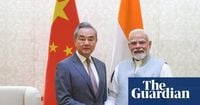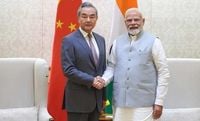After a three-year diplomatic freeze, the world watched this week as China’s top diplomat, Wang Yi, landed in New Delhi for the 24th round of the India-China Special Representative talks—a meeting that many hope signals a new, if fragile, chapter in the relationship between Asia’s two giants. The visit, which took place from August 18 to 20, 2025, comes amid a swirl of shifting global alliances, Trump-era tariffs, and persistent border tensions that have defined the two countries’ recent history.
Wang’s arrival in India marked his first visit since April 2022, a trip that, as reported by The Guardian, was met with a notably cool reception due to his previous stop in Islamabad and contentious remarks on Kashmir at an international forum. This time, however, the tone was markedly different. Both sides appeared eager to project an image of “steady development” and cautious optimism, with Indian Prime Minister Narendra Modi stating on social media that there was now “respect for each other’s interests and sensitiveness.” According to China’s foreign ministry, the two countries had “entered a steady development track” and should “trust and support” one another.
The backdrop to this diplomatic thaw is anything but simple. Relations between India and China plummeted in June 2020 when a deadly clash in the Galwan Valley left 20 Indian and four Chinese soldiers dead—the worst violence between the neighbors in decades. The incident brought formal talks to a halt, with the last round of Special Representative discussions having taken place in December 2019. It wasn’t until December 2024, following a face-to-face between Modi and Chinese President Xi Jinping in Kazan, Russia, that the two sides agreed to resume dialogue.
In the months leading up to Wang’s visit, momentum for engagement had been building. India’s defense minister and national security advisor visited China in June 2025, followed by External Affairs Minister S. Jaishankar’s trip to Beijing in July. These moves set the stage for Modi’s own highly anticipated visit to China later in August—his first in seven years—where he is expected to meet with Xi Jinping and attend the Shanghai Cooperation Organisation (SCO) summit in Tianjin.
During Wang’s stay in New Delhi, both countries pledged to resume direct flights, a step first promised in January but now reaffirmed with new urgency. They also agreed to issue visas to journalists and facilitate greater business and cultural exchanges. Limited border trade has been reopened, and India has relaxed visa policies for Chinese nationals, while engaging with select Chinese firms to secure crucial supply chain components for its manufacturing sector. For China’s part, it has eased export curbs on fertilizers, rare earth minerals, magnets, and tunnel-boring machines—inputs vital to India’s infrastructure and “Make in India” ambitions.
“The setbacks we experienced in the past few years were not in the interest of the people of our two countries. We are heartened to see the stability that is now restored in the borders,” Wang said, as quoted by The Guardian. The symbolism of resumed flights and pilgrimage access to Kailash–Mansarovar is not lost on either side, serving as gestures of goodwill meant to restore public perceptions of normalcy.
Yet, as Bloomberg and China Global South both point out, the rapprochement remains tentative. Deep-seated irritants persist, including the lack of data-sharing on Himalayan rivers, the contentious question of the Dalai Lama’s reincarnation, and most crucially, China’s strategic partnership with Pakistan. China supplies over 80% of Pakistan’s defense imports and provided intelligence support during recent India-Pakistan clashes. Wang’s scheduled trip to Islamabad after New Delhi—to co-chair the sixth Pakistan-China Strategic Dialogue and review the China-Pakistan Economic Corridor—underscored the delicate balancing act Beijing must play as it seeks to enhance cooperation with both India and Pakistan, despite their rivalry.
India’s Foreign Minister Jaishankar, during talks with Wang, raised concerns about China’s plans to build the world’s largest hydropower dam on the Yarlung Tsangpo river in Tibet, a project Delhi fears could have significant impacts on downstream communities. The two sides also discussed “de-escalation, delimitation and boundary affairs,” with Chinese state media noting an agreement to “explore the possibility of advancing boundary demarcation negotiations.” Still, both countries continue to fortify their borders, even as they withdraw some additional forces and agree to new border patrol pacts.
Much of this diplomatic recalibration is taking place against a backdrop of global upheaval. Donald Trump’s aggressive trade tariffs, including a 50% punitive tariff on India over its purchase of sanctioned Russian oil, have strained US-India relations and forced New Delhi to reassess its strategic options. As Sana Hashmi, a fellow at the Taiwan-Asia Exchange Foundation, told The Guardian, “The US president’s tariffs and the perception of a reduced US presence in Indo-Pacific partnerships had contributed to and accelerated efforts to stabilise the India-China relationship.” However, she cautioned, “Core security issues and the overall nature of India-China relations will not change because of Trump’s policies, and the Indo-Pacific framework will continue to shape regional dynamics.”
Wang Yi, for his part, placed the dispute in a broader context, warning that the world faces “a once-in-a-century transformation at an accelerating pace,” and urging resistance to “bullying” tactics—a pointed critique of Washington and a nudge for India to deepen its involvement with the BRICS bloc of middle powers. Modi, meanwhile, has been careful to emphasize India’s desire for “reformed multilateralism” and to diversify its technology and investment sources, seeking to avoid over-dependence on either China or the US.
Despite the diplomatic progress, the power asymmetry between the two countries remains. India’s Atmanirbhar Bharat (self-reliant India) vision hinges on acquiring technology transfers to build up its manufacturing base, but Chinese companies, like others, are reluctant to share advanced technologies without strict conditions. Some joint ventures are emerging, but both sides are acutely aware of the risks of overexposure.
As Modi prepares for his trip to China—his first since 2018—the world will be watching closely to see whether this cautious thaw can deliver more than symbolic gestures. The stakes are high: with both countries vying for influence in a turbulent global order shaped by Trump-era tariffs and “America First” nationalism, even modest progress could have outsized significance. For now, both New Delhi and Beijing appear committed to “managing tensions while navigating turbulent waters,” as Hashmi put it. In an era when even modest diplomatic achievements can feel monumental, the resumption of dialogue between India and China is, at the very least, a step in the right direction.


